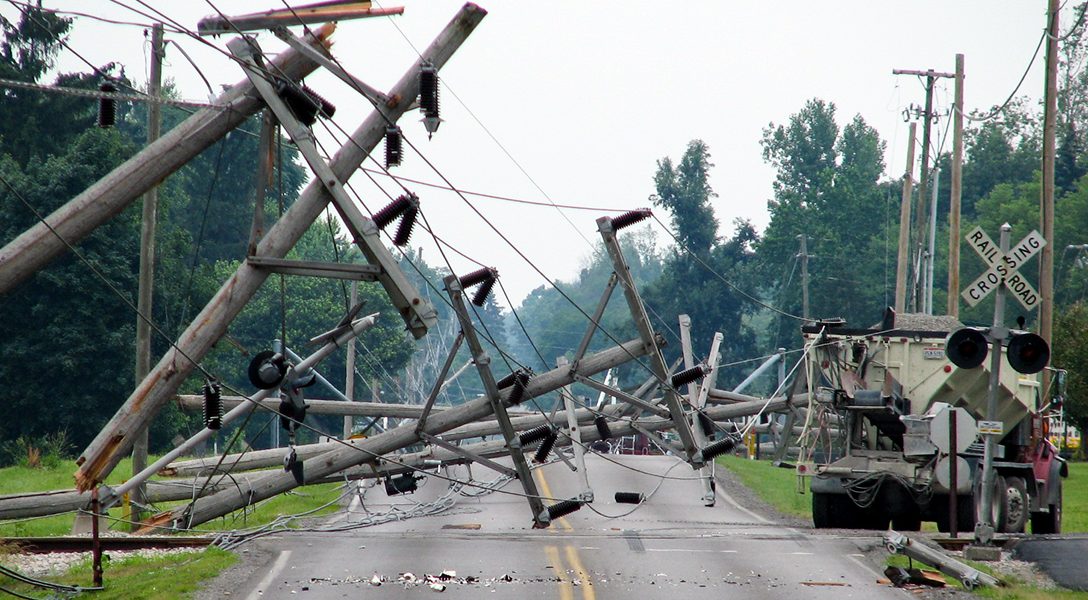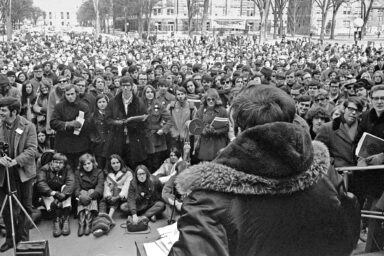America’s Electrical Grid Is Falling Apart
Texas Gives Us a Small Peek at How Bad Things Can Get
The United States is trying to deliver 21st century energy over early 20th century wires.
America’s electrical grid is a product of the 1930s. Therefore, just as Americans will need new highway infrastructure for the autonomous cars of the future, they will also need a new electrical infrastructure for 21st century energy sources such as wind and solar. Since Texas pretty much has its own grid, Hurricane Harvey had little impact on electrical transmission outside the state. However, if a similar storm had impacted the Eastern or Western grids, the “cascade” effect could have blacked out much of the country.
And the problem is not limited to the aging wires themselves. In this week’s WhoWhatWhy podcast, McGill University professor Gretchen Bakke, author of “The Grid,” explains why the current US system runs counter to how energy will have to be delivered in the future. Where once the idea was big power plants, far from cities, serving huge regions, today’s energy needs are best met closer to communities. In addition, Bakke tells Jeff Schechtman that advanced computer technology will be essential for ascertaining energy needs and controlling the flow into our homes and businesses.
Bakke says that while everyone is looking for the holy grail of mass-scale energy storage in battery farms and the like, Americans could bypass that entirely if they rebuilt their energy infrastructure. She also points out that in 50 years, Americans may look back on the system they have now as pretty much equivalent to the horse and buggy.
If you’re planning to flip on that electrical switch anytime soon, best take a listen to this week’s WhoWhatWhy podcast.


Click HERE to Download Mp3
Full Text Transcript:
As a service to our readers, we provide transcripts with our podcasts. We try to ensure that these transcripts do not include errors. However, due to a constraint of resources, we are not always able to proofread them as closely as we would like and hope that you will excuse any errors that slipped through.
| Jeff Schechtman: | Welcome to Radio WhoWhatWhy. I’m Jeff Schechtman. We’ve heard over and over again how fragile our nation’s electrical grid is under normal circumstances. In Texas, we’re seeing up close and personal what happens when the grid goes down. It’s only because Texas, unique in the U.S., has its own grid that the impact has not been felt much further away. Add to all of this the great efforts that are being made in the realm of clean energy. Things like wind and solar and wave energy are all moving forward, but given the state of the grid, how do we get these new electrical energies delivered to us? The wires and infrastructure that currently deliver them are the product of the 1930s, hardly viable for delivery of 21st Century energy. Further, after reading Michael Lewis’s breathtaking story about the Department of Energy, we certainly can’t be looking to the government to do anything about it. |
| So what do we do about the grid, and what’s the price for doing nothing? All of this brings us to our guest, Gretchen Bakke. Gretchen holds a PhD from the University of Chicago. She’s a former fellow at Wesleyan University’s Science in Society program and currently an assistant professor at McGill University. It is my pleasure to welcome Gretchen Bakke here to Radio WhoWhatWhy to talk about her new work, The Grid: The Fraying Wires Between Americans and Our Energy Future. Gretchen, thanks so much for joining us. | |
| Gretchen Bakke: | Thank you so much for inviting me. |
| Jeff Schechtman: | I want to begin by talking a little bit about the grid that we have today, the wires, the infrastructure, that brings us electricity today, and a little bit how they grew up beginning in the 1930s. |
| Gretchen Bakke: | Yeah, so the system we have today, which is slowly breaking down, I have to say … So I could say the system we had 7 years ago or 10 years ago, which we still largely have today, is very big power plants often run on coal, nowadays on natural gas, on nuclear, occasionally on hydro. Big hydroelectric dams are the same kinds of very big power plants that are located far away from where people live, and the reason for that is that they used to be coal plants, and so if you had them in cities the pollution was just absolutely terrible. I remember stories that my grandmother told me about being in Chicago in the 1930s, and every time she had to set the table she had to wipe the coal dust off the table with a rag. |
| And so for good reason, the plants moved further and further away from town, and electricity was then supplied by these high-voltage power lines, which is called the transmission system. And we … And you see them now everywhere. Any time you’re on a big drive, it’s the ones with the big metal pylons. Just huge, high-voltage wires way up above the ground that just sort of traverse the country, and those come in, then, to populated areas, go into a substation, and the voltage comes way, way down, and then that is the power that’s distributed to the people. | |
| And then the quirky thing about the American system is that it was designed so that we could use as much electricity as we wanted, whenever we wanted, and that everything would be controlled, everything would be made available, at the power plant. So there’s some people sitting in rooms that are deciding how much electricity needs to be produced at any given moment while we just turn things on and turn things off without ever having to think about it. | |
| Jeff Schechtman: | And that is one of the other important points of all of this, that electricity is something that has to happen and be provided in real time because of the inability of storage. |
| Gretchen Bakke: | Right, exactly. So even though we tend to think that there … Nowadays, we tend to think that there is a way to store electricity because we have batteries everywhere, these little batteries like in our phones and even in our cars now with Tesla. But the fact of the matter is that grid scale, there’s almost no way to store electricity, which means that when a lump of coal is pulverized and flash-combusted and turned into electricity, in less than a minute that electricity has to be used, which is this crazy balancing act because you have people on the one side, you and me, who are just using electricity as we like, and people on the other side trying to manage a power plant thinking of us all in some sort of aggregate without really knowing who we are but kind of guessing that we’ll use more at 5 p.m. than we’re using at noon trying to supply exactly the same amount of electricity at the plant. |
| And now that things are going digital, the information that’s coming back to the power plant is every five seconds, what use is on the system every five seconds. You try to imagine what managing that system was like in the 1970s before computation, computers, were integrated into it at all. | |
| Jeff Schechtman: | And talk a little bit about what’s fundamentally changed with respect to alternative energy today—wind, solar, and the like—and why it is inconsistent and even arguably incompatible in some respects with this current grid system that we have. |
| Gretchen Bakke: | There’s two things that wind and solar and tidal power, which will probably become more popular to do, that it’s very, very unlike the system, sort of the 20th Century system, you could call it. The first is that wind and solar produce electricity when there’s wind or when there’s sun, so it’s not how much electricity is being produced is not set at the power plant anymore. So if you have a lot of wind and it’s a very windy day, you have a lot of electricity. But nevertheless, on the user side, we’re still just turning things on and turning them off as we like. |
| And the same thing with solar. When the sun is shining very brightly, there’s a lot of electricity, but even if there’s … Obviously at night, there’s no electricity on a solar system. But even if there’s a puffy, white cloud that crosses Phoenix now, you can see that dip as it passes over every solar panel in the electricity system, and that’s because there’s no storage in that system. And there’s also less inertia, which is sort of another complicated story, but big power plants have a lot of inertia, and it allows for a little bit, just the heaviness of their machinery, it will keep turning regardless of how much electricity is going in at this second. It will turn for a little while, it’ll turn for a minute. And that actually was a way of balancing the system previously. Wind turbines do have that, but solar panels don’t. | |
| So that’s one problem is that electricity is now being produced variably, we say, but it’s not being used, necessarily, in a way that matches the variability of production. | |
| Jeff Schechtman: | So it seems that as we look at all of this there are really two majors problems that we’re facing. One, that the current grid is really not set up for the kind of energy that we’re talking about today, and what does exist in terms of the current grid is fraying and becoming old, and the infrastructure is falling apart. |
| Gretchen Bakke: | Yeah. And I was even just talking to some investors a couple of weeks ago, and they were saying, “You know, it’s this big question when a coal plant even goes up for sale now. Nobody even knows what a coal plant is worth.” So it used to be … This used to be centerpiece of the way that we made electricity in America, and now they’re being decommissioned quite rapidly, and even the ones that are there that somebody might buy and need to fix up, nobody even knows if it’s going to cost more to take care of that coal plant than you would ever make out of it. So it’s not just that the energy system is changing, it’s as the energy system changes, the financing of all of these different pieces of the grid also changes. |
| And America’s grid has always developed because of ways that people figure out how to make money off of electricity. It’s another unique feature of the U.S. system is that … The electricity system, it’s there for making money. The grid is there for making money, and it’s there for making electricity, and both of those things really matter to the way in which it unfolds. And there’s a lot of excitement on the investor side today also about renewables, about putting money into renewables, and less excitement, certainly, about coal, about nuclear, but even natural gas there’s questions about what will happen over the long term. | |
| Jeff Schechtman: | What about the issue of storage today? And certainly more and more talk about that, about better batteries, and really an offshoot of some of the things that are happening in terms of moving towards electricity, even in our cars. |
| Gretchen Bakke: | Yeah, so storage is … Storage is … I call it in the book “the holy grail.” So there’s a lot of people that are really looking and working very hard to figure out how to do grid-scale storage, and there are many people that are trying to figure out systems in which we actually just shrink down electricity production so that it’s happening closer to the house in smaller amounts, or closer to where we use it in smaller amounts, and then the storage itself can be smaller, which is technologically easier to do. |
| But there’s also, and I think this is the way that things … Storage will always be a part of the story, but I think where things are actually going to go is that we’ve managed, we and every other developed nation on the planet, managed for a century to have universal electricity without storage. And the reason for that was partially planning, and it was also what is called “balancing.” And so what now has to happen is that we have all of this variable generation, solar and wind, and so what we need to balance it is flexible generation. So a coal plant is very slow to turn up and to turn down, but hydroelectricity is not. You can adjust the amount of water coming through a turbine in a dam very fast in very small scales. | |
| And so it also sort of … The search, then, is for how can we match all this variable with more flexible things we can turn up and turn down? And computerization even allows us now to begin to think about turning up and turning down use. So it’s not everything happening on one side. It’s not everything being planned on the production/generation side. | |
| Now, the way things are shifting—and this, again, is the last 10 years—is for some sort of control of the way that Americans use when … mostly when and how much electricity we use and making that also a resource that’s available to balancing the grid. And that’s mind-boggling. I say it in this very simple way, but it’s mind-boggling to imagine that I could set up a computer system that says to you, “Right now your electricity is going to be very, very expensive if you use it right now.” And so your house, not even your brain but your house, will respond to that by saying, “Well, at this particular moment in time, I will either turn down all the lights or dim everything or sort of turn off the dishwasher, all of these things which are using electricity.” Or if you have a home solar system with batteries, it will say, “Well now I’m going to switch to my own small batteries and pull this entire house off the grid.” So you then become a resource to the grid to balance, even though the storage that you have is very, very little. | |
| Jeff Schechtman: | What has to happen in terms of public policy to make this future viable? |
| Gretchen Bakke: | All kinds of things. There’s … The struggle right now is that the change that’s happening to the system is just absolutely outpacing the regulations. So the regulations that are in place … There are things that have happened over the last 40 years, and the regulations are always trying to keep up with that, but right now the management of the grid and ideas about the grid and even just the fallout from some earlier regulation, like now people can have private high-voltage transmission lines, whereas before that was always something that was managed by the utility. Now, the utilities in almost all states, because of deregulation, don’t own generation. So people can put up a wind farm wherever it’s windy, and the utility has to figure out how to make the grid not crash as all of this electricity is coming into the grid at exactly the wrong time. |
| One of the things that’s happening as more and more people are having home solar systems is that they want to sell their electricity to other people that they know. So instead of having the utility be the one that… you always buy your electricity from them, you always pay your bill to them … And instead of producing electricity just for yourself, people want to start to sell it on an open market. That’s currently illegal in the U.S., but there are people doing it anyway. | |
| So there’s a lot of policy work, and I would say right now that is the battle ground. The shifts that have happened in terms of the popularity and the technology and the price of renewables, that is already in place, but the … There’s a lot of policy work that has to be done in order to make things interoperable with each other so that the grid actually does continue to be stable; to make sure that it’s not just rich people who have houses to put solar panels on that get these new deals while people who aren’t rich—renters, poor people, itinerant people—end up paying into this very big, old system which isn’t working very well, ’cause it probably … Well, who knows what will happen, but it’s possible that the bigger grid will become less reliable over time as the smaller systems become more robust. | |
| So there’s a lot of thinking about the kind of country we want to live in, how much that is going to cost, and how to, to my mind, include everybody into this major infrastructural change. And that was actually also an issue in the 1920s. So when we got the grid we have now, as that was slowly put into place and the regulations and the policy and the money-making side of it were all worked out in the trenches, these were the same questions that were being asked of the country. But that was the Great Society moment. It was the Great Depression, in fact, for a part of it, and that … The ideas that were prevalent at that time about equal opportunity really were built into the electricity system that we’re now dismantling. So we have to ask all those questions again. | |
| Jeff Schechtman: | And if we’re asking those questions, we also have to anticipate for something that doesn’t even exist yet in terms of what you were talking about before with respect to the holy grail being storage and the ability for storage on a mass scale which doesn’t exist yet but certainly might down the road. |
| Gretchen Bakke: | Yeah, it might down the road. And what might happen is that while we’re waiting for it to exist, we’ll figure out another system that will work, which is sort of precisely what happened in the 1930s. They also needed storage, and they also didn’t have it, and so they figured out something else that worked. So we have a lot more storage than has ever been on the grid right now, and there are a lot of big brains in big and small places trying to figure this out. |
| And they’re not all super high-tech. One of those stories that I absolutely adore is this very, very heavy train. I believe it’s in Utah. It might be in Nevada. But essentially it’s this insanely heavy train, and it’s beiged-out like the desert. You can’t even see it from far away. And when there’s excess electricity on the grid, because they have a lot of solar power there, they use that electricity to run this train up a mountain. And then when they need electricity, at night for example, they let the train just run back down the mountain by gravity, and that then generates excess power. So in a way it’s a kind of storage, right? It’s a way … There’s no electricity that’s stored, but the electricity is being used and being reproduced at roughly the same amount but at a different time of day. | |
| So it’s not just computers and it’s not just batteries that are being tested out. There’s mechanical storage, there’s thermal storage, there’s inertial storage. There’s all kinds of ideas out there. | |
| Jeff Schechtman: | We’ve talked a little bit about the regulatory aspects of this. Talk about, in terms of the progressive aspect, how much of it is going to happen by virtue of government getting involved in it, and how much is going to happen by virtue of the private sector getting involved? |
| Gretchen Bakke: | Well, right now it’s almost all the private sector. And, so the … But that doesn’t mean … When you’re talking about something as big as America, there is this moment at which regulation becomes extremely important in order to keep a big system like this functioning. And so that’s the push and pull that we have right now is that … It’s not just private sector, it’s all grassroots. You see in Minnesota, there are people who’ve been working for 30, 35 years on solar, and they never believed that the price would ever come down so low that it could completely go mainstream. So they’ve been in it their whole lives, and now suddenly they’re the advocates for solar everywhere, small solar everywhere, and trying to figure out ways to finance that and make that available to all of the people in Minnesota. But they’re also the ones who are running the companies. So it’s private sector, but it’s private sector that came up from a grassroots philosophy. |
| And you all see this in the … There are towns which are now municipalizing their electricity system, so they’re getting … They’re basically divorcing their utility. And again, it’s a very grassroots kind of movement to say, “We’re going to decide how our power is made, where it’s made, how much we charge people for,” and this kind of shattering of the utility system. So that’s the … And then there are also utilities who are very forward-thinking, and they’re trying to figure stuff out as well. So there’s a lot of players. | |
| And the reason that I love researching this project in the U.S. and I think it’s really worth writing about in the U.S. is that this transition is happening everywhere, the transition from fossil fuel power to renewables, but in the U.S. there are so many more players. It’s such a mess. And because it’s a mess, you get some of the most innovate solutions to things, or curious things kind of just come out of what looks like chaos that actually really, really work, and then those get picked up in other places. So, that’s the great benefit. There’s also a lot of terrible ideas, and there’s things that don’t work at all. So it’s … You get both of those things in the U.S. story. | |
| Jeff Schechtman: | One of the other things that we hear a lot about is the vulnerability of the existing grid, both in terms of its aging out and also just the potential danger to it. |
| Gretchen Bakke: | Yeah, it is very vulnerable, and there are a lot of reasons for that. One is that it’s so big. We actually have three grids in the U.S. We have one for the East Coast, one for the West Coast, and one for Texas. And the kinds of blackouts, like we had on the East Coast grid in 2003, that’s a … It’s called a “cascading blackout,” and it’s basically a blackout that’s produced by interconnectedness. So it would be a small blackout if it wasn’t such a big grid, but because it’s so big it just cascades across different states, different parts, different regions. And so there’s a lot of asking questions about how it’s possible to what’s called “island” a piece of the grid in order so if there is a cascade it can actually stop that cascade. So when people talk about microgrids, one of the things they mean is something which is more resilient. So like after Sandy, superstorm Sandy, the microgrids came back online after about an hour, whereas the big grid was out for almost a week. So there’s that appeal to microgrids, but microgrids also stop cascades, so these blackouts that just roll for no particular reason except that all of the infrastructure is connected. |
| The second and very surprising fact is that the largest threat to our energy infrastructure in the U.S. is actually trees and other sorts of green, growing things. So there’s clearly is a worry about terrorists and what terrorists can do to this massively interconnected infrastructure, but at present the thing that’s constantly bringing it down is just plant life and squirrels. So there’s the big worries, especially to not have a hackable grid, but then there’s also what do you do about trees? It’s very expensive to constantly be trimming these trees back. What do you do about squirrels? Nothing. There’s nothing that we can do about squirrels. They’re just going to cause outages willy-nilly from now until the end of time, unless we really get rid of wires completely, which is unlikely. | |
| Jeff Schechtman: | When we talk about hardening the grid, and that’s a phrase we hear a lot about, what does that really mean? |
| Gretchen Bakke: | It can mean two different things depending on who you’re talking to. In the simplest terms it means getting, making the infrastructure less harder … Less hard … No, how do I say this? Making the infrastructure less easy to break, so making it harder to break. And it can be things like taking wooden poles and replacing them with cement or steel. It can mean things like putting a substation on a little hill in an area which is easily flooded, so instead of just building on the flat, it can mean moving your critical electrical infrastructure to the second floor of a building instead of keeping it in the basement. These are all considered hardening, which just means in case of some sort of emergency, the system is less likely to break. |
| It also nowadays links more to the idea of resilience. So the two are beginning to become interconnected, the two sets of terms. They used to be quite opposite. But a resilient grid is a grid that when it breaks, it just bounces back more quickly. So, part of making a resilient grid is actually doing some of these hardening procedures. The difference is that if you only think in terms of hardening, you’re always trying to keep the thing from being broken, whereas if you think in terms of resilience you’re trying to keep it from being broken, but if it’s broken you want to be able to fix it much, much more quickly. So it’s sort of an added level of wisdom, I would say, to think in terms of resilience, ’cause you do all these hardening things, too, but you also imagine the next step, which is like no matter what, one day there’s going to be that storm of the century, and it’s going take this thing down. So how can we also build it so we can bring it back up again? | |
| And there’s quite simple stuff there, too, as well. For example, for a long time, substations were not built in the U.S., and so if a substation went down, it took a really long time to get a replacement. And now we do build substations in the U.S. | |
| Jeff Schechtman: | And finally, talk a little bit about the timeframe that you see for so many of the things that we’re talking about in terms of some of these changes really beginning to take place. |
| Gretchen Bakke: | I think it’s happening much faster than anybody could possibly imagine. I mean, I finished the book a year and a half ago, and the last chapter already feels old. It’s really going fast. It’s really moving very, very fast. And you see things like France just decided that, made a law that there can be no more internal combustion engines in cars by 2035. Britain said that for 2040. So that’s just … How many electric cars are there right now on the road? About 1%. So you imagine if you can’t even buy a car with an engine anymore in 15 years. That’s France, right? That’s not us. But still, you can see this trend happening. And also the cost of solar now, the cost of wind even now, not offshore wind but onshore wind, it’s coming down to the point at where coal is simply not even a contender but it starts to be competitive with natural gas. And so people who are making purely financial decisions are also going to begin to opt more and more for renewables. |
| And then, you also see because of that, the closer that electricity generation is happening to the building or the place where it’s being used, the more efficient those places become. So people become very conscious when they’re making a building and they’re thinking about electricity supply and storage as a part of that building. Suddenly the building gets massively efficient. So the whole smart building, when people talk about smart buildings, that’s also linked to this change in the electricity system. People talk about the Internet of Things. That’s also linked to this change in the electricity system. So, in a way, I would say we spent a lot of time kind of waiting for the 21st Century to happen, the jet packs, like take-a-jet-pack-to-work imaginary 21st Century. And I think that with this transition of the electricity system, it’s actually starting to push all of these fairly radical changes into place. I think by 2070, people are going to look back at the way we did things in the 20th Century and just smack their forehead on the table. It’s just going to be unimaginable how old-fashioned and poorly organized it was. | |
| Jeff Schechtman: | Gretchen Bakke. The book is The Grid: The Fraying Wires Between Americans and Our Energy Future. Gretchen, thanks so much for spending time with us here on Radio WhoWhatWhy. |
| Gretchen Bakke: | Yeah, my pleasure. Thank you. |
| Jeff Schechtman: | Thank you. |
| Thank you for listening and joining us here on Radio WhoWhatWhy. I hope you join us next week for another Radio WhoWhatWhy podcast. I’m Jeff Schechtman. If you liked this podcast, please feel free to share and help others find it by rating and reviewing it on iTunes. You can also support this podcast and all the work we do by going to WhoWhatWhy.org/donate. |
Related front page panorama photo credit: Adapted by WhoWhatWhy from power lines (Stephen Edmonds / Flickr – CC BY-SA 2.0) and Bloomsbury USA.



